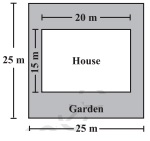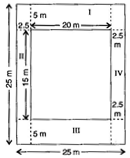Exercise 11.1 Page No: 171
1.A square and a rectangular field with measurements as given in the figure have the same perimeter. Which field has a larger area?

Solution:
Side of a square = 60 m (Given)
And the length of rectangular field, l = 80 m (Given)
According to question,
Perimeter of rectangular field = Perimeter of square field
2(l+b) = 4×Side (using formulas)
2(80+b) = 4×60
160+2b = 240
b = 40
Breadth of the rectangle is 40 m.
Now, Area of Square field
= (side)2
= (60)2 = 3600 m2
And Area of Rectangular field
= length×breadth = 80×40
= 3200 m2
Hence, area of square field is larger.
2. Mrs.Kaushik has a square plot with the measurement as shown in the figure. She wants to construct a house in the middle of the plot. A garden is developed around the house. Find the total cost of developing a garden around the house at the rate of Rs. 55 per m2.

Solution:
Side of a square plot = 25 m
Formula: Area of square plot = square of a side = (side)2
= (25)2 = 625
Therefore the area of a square plot is 625 m2
Length of the house = 20 m and

Breadth of the house = 15 m
Area of the house = length×breadth
= 20×15 = 300 m2
Area of garden = Area of square plot – Area of house
= 625–300 = 325 m2
∵ Cost of developing the garden per sq. m is Rs. 55
Cost of developing the garden 325 sq. m = Rs. 55×325
= Rs. 17,875
Hence total cost of developing a garden around is Rs. 17,875.
3. The shape of a garden is rectangular in the middle and semi-circular at the ends as shown in the diagram. Find the area and the perimeter of this garden [Length of rectangle is 20 – (3.5 + 3.5 meters]

Solution::
Given: Total length = 20 m
Diameter of semi circle = 7 m
Radius of semi circle = 7/2 = 3.5 m
Length of rectangular field
= 20-(3.5+3.5) = 20-7 = 13 m
Breadth of the rectangular field = 7 m
Area of rectangular field = l×b
= 13×7= 91m2
Area of two semi circles = 2×(1/2)×π×r2
= 2×(1/2)×22/7×3.5×3.5
= 38.5 m2
Area of garden = 91+38.5 = 129.5 m2
Now Perimeter of two semi circles = 2πr = 2×(22/7)×3.5 = 22 m
And Perimeter of garden = 22+13+13
= 48 m. Answer
4. A flooring tile has the shape of a parallelogram whose base is 24 cm and the corresponding height is 10 cm. How many such tiles are required to cover a floor of area 1080 m2? [If required you can split the tiles in whatever way you want to fill up the corners]
Solution:
Given: Base of flooring tile = 24 cm = 0.24 m
Corresponding height of a flooring tile= 10 cm = 0.10 m
Now Area of flooring tile= Base×Altitude
= 0.24×0.10
= 0.024
Area of flooring tile is 0.024m2
Number of tiles required to cover the floor= Area of floor/Area of one tile = 1080/0.024
= 45000 tiles
Hence 45000 tiles are required to cover the floor.
5. An ant is moving around a few food pieces of different shapes scattered on the floor. For which food-piece would the ant have to take a longer round? Remember, circumference of a circle can be obtained by using the expression C = 2πr ,where r is the radius of the circle.

Solution:
(a) Radius = Diameter/2 = 2.8/2 cm = 1.4 cm
Circumference of semi-circle = πr
= (22/7)×1.4 = 4.4
Circumference of semi-circle is 4.4 cm
Total distance covered by the ant= Circumference of semi -circle+Diameter
= 4.4+2.8 = 7.2 cm
(b) Diameter of semi-circle = 2.8 cm
Radius = Diameter/2 = 2.8/2 = 1.4 cm
Circumference of semi-circle = r
= (22/7)×1.4 = 4.4 cm
Total distance covered by the ant= 1.5+2.8+1.5+4.4 = 10.2 cm
(c) Diameter of semi-circle = 2.8 cm
Radius = Diameter/2 = 2.8/2
= 1.4 cm
Circumference of semi-circle = π r
= (22/7)×1.4
= 4.4 cm
Total distance covered by the ant = 2+2+4.4 = 8.4 cm
After analyzing results of three figures, we concluded that for figure (b) food piece, the ant would take a longer round.
Sir it is helping a lot
ReplyDelete